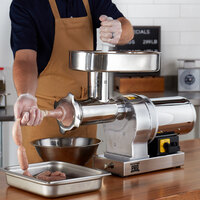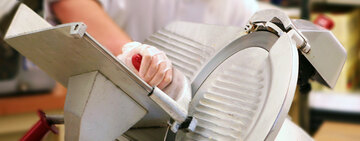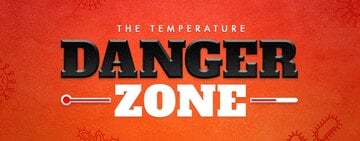
Commercial Meat Grinder Buying Guide
Making your own freshly ground beef or sausage is one way you can set your restaurant apart from the competition. Any establishment where meat is prepared, from a butcher shop to a deli counter, will likely want to have at least one commercial meat grinder available for use. Finding the best meat grinder for your needs is a relatively simple process. Once you understand what is available, and evaluate your own specific needs, you'll be able to find the right one for you!
Types of Meat Grinders
Like most pieces of commercial kitchen equipment, meat grinders are available in a variety of sizes and configurations.

Manual meat grinders mount to your table or countertop and are designed for low-volume use. Because of their relatively small capacity and the need to turn the crank by hand, this type of grinder likely won't be used too often in a commercial setting.
Purchasing Considerations
- Use a table clamp to stay in place, as some models won't attach to a thick table
- Not intended for frequent commercial-level use
Electric meat grinders come in a variety of sizes, from small countertop units all the way up to large, high-output floor mounted models that are best suited for meat processing facilities or busy butcher shops or meat counters.

It's important to pay attention to the number of pounds of meat a particular meat grinder can process per minute (or per hour) when comparing models. If you purchase a unit that can't keep up with your output requirements, you'll shorten its life and negatively impact your own productivity.
Purchasing Considerations
- Match the output of the machine to your business needs
- Pay attention to the materials and construction of the grinder; stainless steel is dishwasher safe and resists corrosion
Horizontal food cutters, more commonly known as Buffalo choppers, are an extremely versatile piece of equipment that are able to shred chicken, pork, and other meats that you don't want finely ground. They also work great for making things like coleslaw, potato salad, chicken salad, and more because you can add seasonings and sauces as you're cutting the meat or vegetables. Some models even boast a powered take-off hub (PTO) where you hook up a meat grinder or vegetable slicer attachment to have the best of both worlds!
Purchasing Considerations
- Decide whether you want to purchase a model with a #12 hub
- Pay attention to safety features; the blade is more exposed on this type of unit
- Evaluate space; these models can take up a bit more countertop space than a traditional countertop meat grinder
Common Accessories and Related Products
Sausage Stuffer Attachments and Sausage Stuffers
Many meat grinders have an optional sausage stuffing tube or tubes of varying sizes that you can use to grind meat directly into casings for hot dogs and sausage. Using a stuffing tube with a meat grinder, particularly if you don't have a "stuffing die," can be a slow process because the machine doesn't output the ground meat nearly as quickly as a dedicated sausage stuffing machine. If you want to produce a lot of sausage or hot dogs, you'll be much happier and more productive with a standalone sausage stuffer.
Meat Mixer
A meat mixer is a relatively simple product, where you add ground meat and seasonings to a hopper and turn a crank to mix the product together. This is great for sausage, meatloaf, meatballs, and other seasoned meat products. A few of the largest commercial meat grinders we offer have this capability built-in, which is helpful for food processing or extremely high output situations.
Multiple Grinding Plates
Most meat grinders come with several sizes of grinding plates, or dies, with holes of varying sizes. And with many manufacturers, additional sizes are available for purchase separately. Obviously, the smaller the holes, the more finely ground the final product will be. For the smaller grind sizes, it's best to grind the meat starting with the largest hole size first. Then, re-grind the meat through successively smaller grinding plates to achieve the best results. Follow the guidelines below for optimal results.
- 3/4" - Very coarse. Good for first grind and chili/stew meats.
- 1/2" - Very coarse. Good for first grind and chili/stew meats.
- 3/8" - Coarse. Good for first grind, chili/stew, chorizo.
- 1/4" to 5/16" - Coarse. Good for bratwurst or hamburger.
- 5/32" to 3/16" - Medium. Good for hamburger, breakfast sausage, or Italian sausage.
- 3/32" to 1/8" - Fine. Good for hamburger, bologna, or jerky.
Meat Grinder Tips and Tricks
- Most commercial meat grinders are not really designed for animal bones.
- Don't take your meat out of the refrigerator until you're ready to grind it.
- Chill your grinding plates, knife, feed tube, and auger in a freezer or ice bath before grinding a batch of meat. Since grinding creates friction and will warm the meat up, keeping everything as cool as possible will help with food safety!
- Cut the meat into evenly sized chunks and feed it through the funnel gently; don't force it!
- A sharp cutting knife is a must. Replace dulled ones for better performance!
- Thoroughly clean and sanitize all components immediately after use. Stainless steel components are dishwasher safe!
- For cast aluminum or cast iron components, try storing them in a small food pan with some cornstarch. It will absorb excess moisture.
- Use a food-safe lubricant to maintain and protect all moving parts.
Identifying Your Grinder
If you need to figure out what size grinder you have, measure one of your grinder plates across the center to get the diameter. Check that measurement against this table to find your hub size.
Plate Diameter |
Grinder / Hub Size |
|---|---|
Related Resources

Meat Slicers Buying Guide
In this meat slicing guide, we will explore everything you need to know about meat slicers , helping you improve the efficiency of your foodservice establishment and select the best meat slicer for your needs! Be sure to check out our commercial meat slicer reviews as well!

The Danger Zone: Following Food Safety Temperatures
The top priority in a commercial kitchen is understanding and enforcing food safety temperatures. Neglecting them can put customers at serious risk of contracting foodborne illnesses. To ensure food safety , foodservice operators and handlers must understand the temperature danger zone and its impacts. We'll explain the danger zone temperature range, which foods are most at risk, and how to prevent food from lingering at hazardous temperatures. Shop All Kitchen Thermometers Click below to learn about the temperature danger zone: Why Is the Danger Zone Important? How Long Food Can Stay in the Danger Zone How to Hold Cold Food How to Hold Hot Food Danger Zone FAQs What Is the Danger Zone for Food? The danger zone refers to the temperature ran

Commercial Meat Grinder Reviews
Compare machine specifications and customer reviews to choose which commercial meat grinder is ideal for you. All of our grinders are built to withstand daily use in a commercial kitchen, so you can crank out your famous meats. Whether you're making a few hamburger patties per week or hundreds of sausages per day, you can find a meat grinder that will match your level of output. From smaller hand-crank models to ones with electric motors, find the best option for your kitchen with our meat grinder comparison.
- Topics 1343
- Industrial 55
- Troubleshooting Guides 21
- Restaurant Management 128
- Bar Management 55
- Catering Tips 35
- Bakery Management 41
- Food Trucks & Concessions 49
- Advertising & Marketing 37
- Eco-Friendly Tips 11
- Facility Layout & Design 41
- Coffee Shop Tips 27
- Installation & Maintenance 51
- Janitorial & Pest Control 30
- Safety & Sanitation 88
- Startup Tips 104
- Menu Design 10
- Kitchen & Cooking Tips 81
- Hospitality Management 23
- Pizza & Sandwich Shop Tips 35
- Smallwares 37
- Food Prep 88
- Tabletop Items 17
- Disposables 22
- Calculators & Tools 6
- Consumables 52
- Warewashing & Laundry 18
- Cooking Equipment 90
- Food Storage & Refrigeration 51
- Beverage Equipment 34
- Office Supplies 6
- Resource Type
- In-Depth Articles271
- Buying Guides296
- How-Tos93
- Product Reviews77


